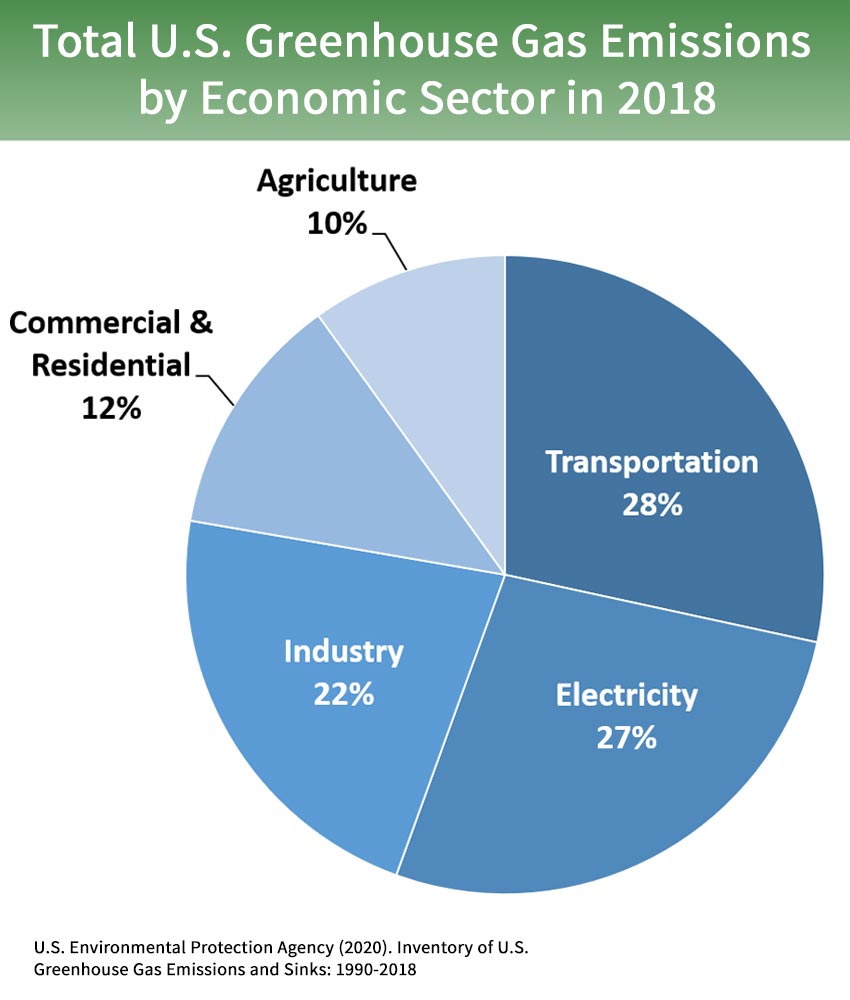Environmental Attributes
Governments at all levels recognize the urgent need to derive energy from renewable sources, and have acted accordingly through passing a variety of measures. Among the most important to RNG are the US Renewable Fuel Standard, the California Low Carbon Fuel Standard, and the Oregon Clean Fuels Program.
Renewable Fuel Standard
The transportation sector is the highest emitter of greenhouse gases in the US.
The Renewable Fuel Standard (RFS) program, which began in 2006 under the Clean Air Act, was designed to tackle GHG emissions by requiring obligated parties to blend renewable fuel with transportation fuel in increasing amounts each year. Aside from clear environmental goals, the program is intended to provide the US with greater energy independence and security.
Obligated parties (refiners and importers) must demonstrate compliance with the RFS program through the use of Renewable Identification Numbers (RINs). RINs are given a D Code based on the fuel’s source and amount of its GHG reduction, with D3 RINs being the most valuable. One MMBtu of RNG generates 11.727 D3 RINs. The RFS program’s four D Codes are nested within each other. Thus, the fuel with a higher GHG reduction threshold can be used to meet the standards for a lower GHG reduction threshold.

| Category | D Code | GHG Reduction | Source Example | Fuel Example |
|---|---|---|---|---|
| Cellulosic Biofuel | D3 | 60% | Biofuel derived from landfills, farms, and wastewater treatment facilities | Renewable CNG and LNG |
| Cellulosic Diesel | D7 | 60% | Crop residue, slash, switchgrass, biogenic components of separated MSW, and cellulosic components of annual covercrops | Renewable diesel |
| Biomass-Derived Diesel | D4 | 50% | Oil from annual covercrops | Biomass diesel |
| Advanced Biofuel | D5 | 50% | Sugarcane | Sugarcane ethanol |
| Renewable Fuel | D6 | 20% | Corn starch | Corn ethanol |
EPA sets annual renewable fuel percentage standards for obligated parties. These percentage standards are used to calculate the number of gallons each obligated party is either required to blend into its fuel, or to determine the number of RINs an obligated party must obtain to demonstrate compliance. Volumes and percentage standards for each D Code decided by EPA in recent years are below.
| Volumes Used to Determine Percentage Standards | ||||
|---|---|---|---|---|
| 2017 | 2018 | 2019 | 2020 | |
| Cellulosic Biofuel (D3 and D7) | 311 million gal | 288 million gal | 420 million gal | 590 million gal |
| Biomass-Derived Diesel (D4) | 2.0 billion gal | 2.1 billion gal | 2.1 billion gal | 2.43 billion gal |
| Advanced Biofuel (D5) | 4.28 billion gal | 4.29 billion gal | 4.92 billion gal | 5.04 billion gal |
| Renewable Fuel (D6) | 19.28 billion gal | 19.29 billion gal | 19.92 billion gal | 20.04 billion gal |
| Final Percentage Standards | ||||
|---|---|---|---|---|
| 2017 | 2018 | 2019 | 2020 | |
| Cellulosic Biofuel (D3 and D7) | 0.173% | 0.160% | 0.230% | 0.340% |
| Biomass-Derived Diesel (D4) | 1.67% | 1.74% | 1.73% | 2.10% |
| Advanced Biofuel (D5) | 2.38% | 2.37% | 2.71% | 2.93% |
| Renewable Fuel (D6) | 10.70% | 10.67% | 10.97% | 11.56% |
The RFS remains a crucial program for RNG on the federal level. State programs provide additional benefits as well.
California’s Low Carbon Fuel Standard (LCFS)
Like the RFS, the LCFS is designed to encourage the use of cleaner, low-carbon transportation fuels which, in turn, reduces GHG emissions. Its jurisdiction, however, is exclusive to California. Another distinction from the RFS is that LCFS standards are expressed in terms of the “carbon intensity” (CI) of gasoline and diesel fuel and their respective substitutes. The program is based on the principle that each fuel has life cycle GHG emissions. Thus, the California Air Resources Board (CARB) examines GHG emissions associated with the production, transportation, and use of a given fuel and provides a carbon intensity score accordingly. The carbon intensity scores assessed for each fuel are compared to a declining CI benchmark for each year. Low carbon fuels below the CI benchmark generate credits, while fuels above the CI benchmark generate deficits. Depending on the project, RNG can generate valuable LCFS credits.
Oregon’s Clean Fuels Program (CFP)
The Clean Fuels Program is similar to the LCFS. The Department of Environmental Quality (DEQ) administers the CFP. Like California, carbon intensity scores are based on a fuel’s total carbon footprint. The CFP’s jurisdiction is exclusive to Oregon, although a fuel that has a carbon intensity score approved by CARB allows the fuel producer to apply to DEQ to accept that score with modifications as needed to reflect its destination to Oregon. Depending on the project, RNG can generate valuable CFP credits.

